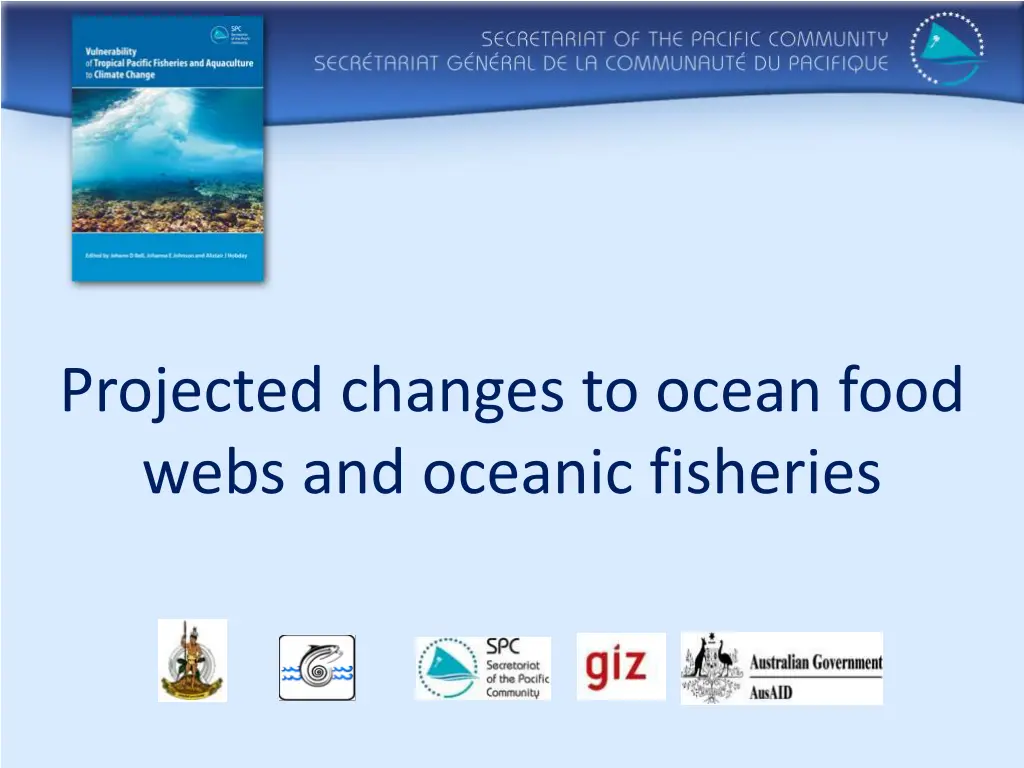
Projected Changes to Oceanic Food Webs & Fisheries
Explore the projected changes in ocean food webs and fisheries, focusing on tuna ecosystems, differences among Pacific Ocean provinces, and the effects of climate change on tuna stocks and oceanic provinces. Discover how climate change impacts phytoplankton, zooplankton, and micronekton, affecting the marine ecosystem. Dive into the intricate relationships within tuna food webs and the habitat temperature preferences of various tuna species.
Uploaded on | 1 Views
Download Presentation

Please find below an Image/Link to download the presentation.
The content on the website is provided AS IS for your information and personal use only. It may not be sold, licensed, or shared on other websites without obtaining consent from the author. If you encounter any issues during the download, it is possible that the publisher has removed the file from their server.
You are allowed to download the files provided on this website for personal or commercial use, subject to the condition that they are used lawfully. All files are the property of their respective owners.
The content on the website is provided AS IS for your information and personal use only. It may not be sold, licensed, or shared on other websites without obtaining consent from the author.
E N D
Presentation Transcript
Projected changes to ocean food webs and oceanic fisheries
Outline Food webs for tuna Differences in food webs among provinces of the Pacific Ocean Effects of CC on provinces and their food webs Effects of climate change on tuna stocks
Tuna food web Food webs are complex
Five oceanic provinces Warm pool Normal El Ni o
Five oceanic provinces North and South Gyres (case 3) and equatorial divergence (case 4)
Impact of climate change Surface area of the provinces Rich equatorial divergence Poorer gyres and warm pool
Impact of climate change Effect on phytoplankton and zooplankton present Present 2035 2050 2100
Impact of climate change Effect on micronekton Shallow micronekton Deep Midwater micronekton Dee micronekton Image: Valerie Allain, SPC
Now, turning to tuna! Albacore
Tuna habitat temperature Each tuna species has evolved with a preferred range in temperature Species Temperature ( C) 20-29 20-30 13-27 15-21 Impacts vertical & horizontal distribution (habitat and food) & reproduction location and timing Skipjack Yellowfin Bigeye Albacore Range of sea surface temperature with substantial catches Source: Sund et al. (1981)
Tuna habitat oxygen Sensitive to combined effects of SST + O2 Less tolerant to low values Estimated lower lethal oxygen Skipjack Albacore Yellowfin Bigeye Species Fork length (cm) 50 50 50 50 Lower lethal O2 levels (ml l-1) 1.87 1.23 1.14 0.40 Skipjack Albacore Yellowfin Bigeye Most tolerant to low values
Tuna habitat oxygen + 0 0 m 100 m Well oxygenated Skipjack Albacore Yellowfin Low oxygen 500 m Bigeye Typical vertical O2 profile Change in subsurface may have more impact on low oxygen tolerant species
Skipjack projection Vanuatu = +2 Vanuatu = +3 Vanuatu = -12 Unexploited Fishing effort x 1.5
Bigeye projection 2000 2000 Adult biomass Larval density 2050 2050 Good fishing grounds could be displaced further eastward
Albacore projection 2000 2000 Adult biomass Larval density 2050 2050 No change in O2 Sensative to O2 so distribution changes With modelled O2
Conclusions There is still uncertainty about impacts of climate change on tuna Fishing has a strong impact and will continue to be a major driver of stocks
Conclusions Resolution 2 Improved resolutions of SEAPODYM model are needed to update these preliminary results Resolution 1 Better projections can be achieved using an ensemble of models Resolution 0.25
